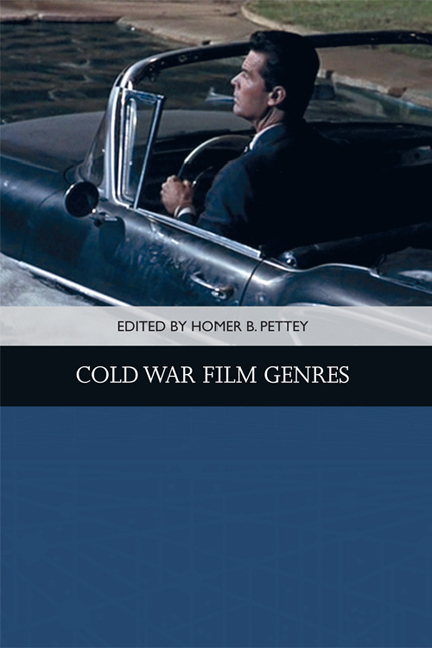Book contents
- Frontmatter
- Contents
- List of Illustrations
- Acknowledgments
- Notes on the Contributors
- 1 Introduction: Cold War Genres and the Rock-and-Roll Film
- 2 Social Factors in Brainwashing Films of the 1950s and 1960s
- 3 The Berlin Crisis? Piffl!: Billy Wilder’s Cold War Comedy, One, Two, Three
- 4 The Small Adult Film: A Prestige Form of Cold War Cinema
- 5 “I’m Lucky – I Had Rich Parents”: Disability and Class in the Postwar Biopic Genre
- 6 Rogue Nation, 1954: History, Class Consciousness, and the “Rogue Cop” Film
- 7 Internal Enmity: Hollywood’s Fragile Home Stories in the 1950s and 1960s
- 8 Suburban Sublime
- 9 Domestic Containment for Whom? Gendered and Racial Variations on Cold War Modernity in the Apartment Plot
- 10 Success and the Single Girl: Urban Romances of Working Women
- 11 Paris Loves Lovers and Americans Loved Paris: Gender, Class, and Modernity in the Postwar Hollywood Musical
- 12 Straight to Baby: Scoring Female Jazz Agency and New Masculinity in Henry Mancini’s Peter Gunn
- Index
8 - Suburban Sublime
Published online by Cambridge University Press: 24 April 2021
- Frontmatter
- Contents
- List of Illustrations
- Acknowledgments
- Notes on the Contributors
- 1 Introduction: Cold War Genres and the Rock-and-Roll Film
- 2 Social Factors in Brainwashing Films of the 1950s and 1960s
- 3 The Berlin Crisis? Piffl!: Billy Wilder’s Cold War Comedy, One, Two, Three
- 4 The Small Adult Film: A Prestige Form of Cold War Cinema
- 5 “I’m Lucky – I Had Rich Parents”: Disability and Class in the Postwar Biopic Genre
- 6 Rogue Nation, 1954: History, Class Consciousness, and the “Rogue Cop” Film
- 7 Internal Enmity: Hollywood’s Fragile Home Stories in the 1950s and 1960s
- 8 Suburban Sublime
- 9 Domestic Containment for Whom? Gendered and Racial Variations on Cold War Modernity in the Apartment Plot
- 10 Success and the Single Girl: Urban Romances of Working Women
- 11 Paris Loves Lovers and Americans Loved Paris: Gender, Class, and Modernity in the Postwar Hollywood Musical
- 12 Straight to Baby: Scoring Female Jazz Agency and New Masculinity in Henry Mancini’s Peter Gunn
- Index
Summary
In 1947, Abraham Levitt, along with his sons, transformed rural grazing land in Nassau County on Long Island into the tract-home, planned community of Levittown which would become a symbol of American middle-class values. The postwar invasion, really a mass white immigration of returning GIs to the suburbs, prompted Hollywood to develop a new cinema of distraction. Middle-class suburbia offered a fertile landscape on which to stage broad physical farces of upward mobility and all of its diversions and headaches – disastrous renovations, unruly appliances, financial woes, and the ever-present threat of adultery. Marriage, as both a social contract and amorous exploit, redefined modern gender roles through a series of comic vignettes on middleclass existence in these films. Central to all of these suburban romps were the visual distractions of mid-century modern architecture, interior design and its lively palette, and contemporary women's fashions from Vogue and Harper's Bazaar, all of which serve as pleasant diversions from toils and troubles of modern life. In these visual pleasures can be found an accepted system of consumption based upon economic and class identification. These suburban comedies, then, offer the visual enchantment of American modernity and gloss over its discontents.
Though patterned after Jack Benny's successful parody George Washington Slept Here (1942), even popular stars Cary Grant and Myrna Loy could not save Mr. Blandings Builds his Dream House (1948) from losing a quarter of a million dollars in its first run in 1948. That year also signaled the beginning of the Cold War with the Berlin Blockade. Two years later, Father of the Bride (1950) would make six million dollars, nearly six times its production budget, probably because its tale of suburban excess held up a mirror to the foibles of the burgeoning American middle class. That film would start a trend in moneymaking suburban comedies for Hollywood throughout the 1950s and ‘60s, producing what can be classified as a film cycle. Even the most modest boxoffice returns proved profitable because audiences flocked to see gently absurd reflections of their own imagined lives. Profits ranged from three million for Rally Round the Flag, Boys! in 1958 to over twenty million a decade later for Yours, Mine and Ours (1968), twenty times its production budget.
- Type
- Chapter
- Information
- Cold War Film Genres , pp. 144 - 162Publisher: Edinburgh University PressPrint publication year: 2018

